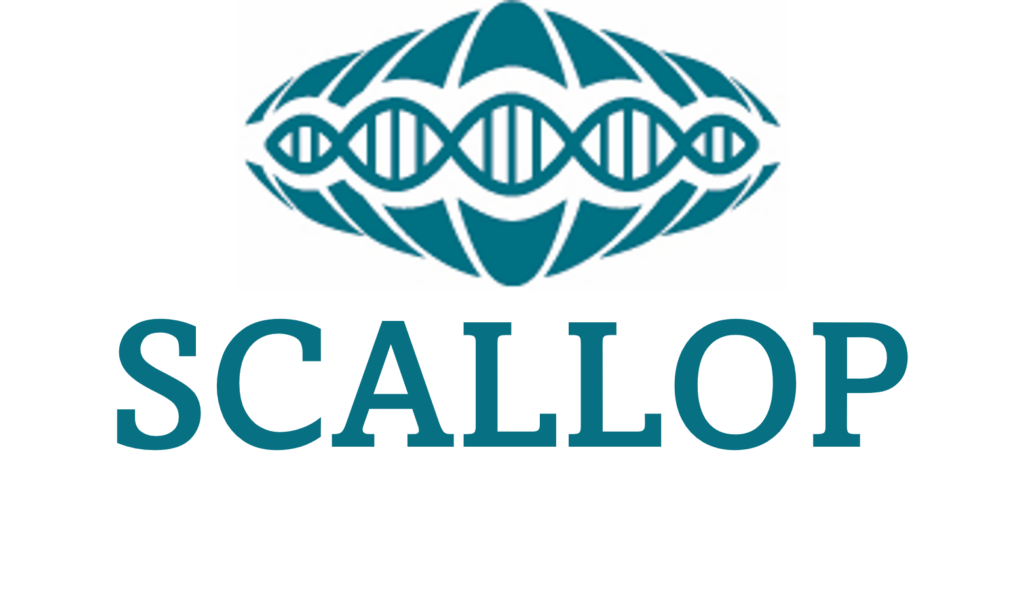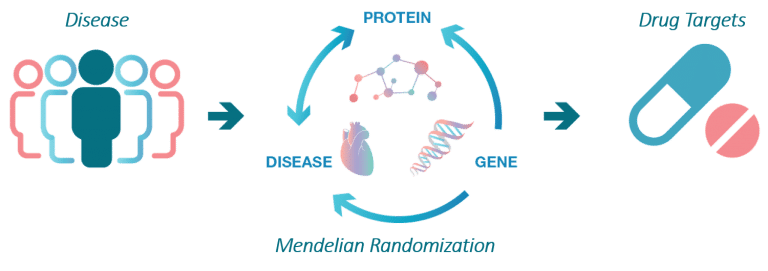
Each SCALLOP member works on human study collections from the general population, clinical trials or patients with certain diseases such as coronary artery disease, rheumatoid arthritis, bipolar disease, heart failure, dementias or metabolic syndrome.
The aim of the SCALLOP consortium is to identify novel molecular connections and protein biomarkers that are causal in diseases.
This work starts with identification of so called protein quantitative trait loci, pQTLs, which are robust connections between a gene variant and the levels of a protein.
There are two types of pQTLs:
- cis-pQTLs are variants that are proximal to the gene encoding the protein under study whereas trans-pQTLs are distal regulation of proteins via an often unknown path.
- Trans-pQTLs can provide unique insights of molecular connections in human biology.
Cis-pQTLs are strong instruments for determining if a protein biomarker for disease is causing disease or elevated or suppressed as a consequence of it. The SCALLOP consortium is currently underway with mapping novel pQTLs for several 100s of proteins in unprecedented sample sizes, something which will yield much deeper insights into the trans-regulation of plasma proteins than what has been possible to date.
Identify causal protein biomarkers

Operations
To be a member of the SCALLOP consortium you have to be the PI of a study collection with Olink proteomics and genome-wide genotyping data. We also expect members to sign up to the Consortium Agreement, which manages conduct and authorships. Download the Consortium Agreement here.
The leadership for subprojects within the SCALLOP consortium rotates and members can take new ideas and suggestions for additional subprojects to the monthly steering committee meetings.
SCALLOP uses a dedicated server for sharing of data. The server is set up under the Danish node of the TRYGGVE server structure. TRYGGVE allows sharing of sensitive data thanks to 2-step authorization procedures and high data security. Thanks to this structure SCALLOP is set up to move to individual-level data should the consortium wish to do so.
Participating cohorts
| Acronym | Disease / Design | Sample size | Olink panels |
| 1000IBD | Crohn’s disease and ulcerative colitis | 1000 | 1 |
| Aristotle | Atrial fibrillation | 1500 | 3 |
| ASAP | Aortic valve surgery | 573 | 5 |
| BAMSE | Childhood asthma | 2000 | 1 |
| Bialystok PLUS | Population based, CVD/CHD | 899 | 5 |
| BioFinder | Dementia | 1550 | 4 |
| CARDIA | Prospective, young adults | 2000 | 2 |
| COLLIBRI (Swedish cohorts) | Cross-sectional | 607 | 2 |
| COSM-C | Population based | 4500 | 3 |
| Dan-NICAD | Stable coronary artery disease | 1650 | 3 |
| DIRECT | Diabetes | 3000 | 5 |
| EpiHealth | Prospective observational | 2500 | 3 |
| Estonian Biobank | Population based | 500 | 4 |
| FastBIO | Population based, observational | 500 | 4 |
| FENLAND | Population based | 500 | 15 |
| FLEMENGHO | Population based | 3500+ | 1 |
| Framingham Heart Study | Population based | 520 | 5 |
| HELIC MANOLIS | Population based | 1356 | 5 |
| HELIC POMAK | Population based | 1537 | 5 |
| I AM Frontier | Deep phenotyping, Longitudinal | 240 | 15 |
| IMPROVE | Prospective, metabolic syndrome | 3403 | 1 |
| INTERVAL | Blood donors | 5000 | 4 |
| Kadoorie biobank | Pancreatic cancer | 1400 | 1 |
| KARMA | Incident breast cancer | 1820 | 2 |
| KORA F4 | Population based | 1050 | 1 |
| LBC1936 | Population aged 72 | 750 | 1 |
| LifeLines Deep | Population based | 1200 | 1 |
| Pfizer/ MadCam_ph2 | Inflammatory bowel disease | 200 | 3 |
| MPP-RES | Heart failure | 1000 | 1 |
| NSPHS | Population isolate | 1000 | 6 |
| ORCADES | Population isolate | 1000 | 15 |
| PIVUS | Prospective observational | 933 | 1 |
| POLRED | Population-based, diabetes | 1500 | 5 |
| PRIDE | Dementia | 1500 | 14 |
| PROCARDIS | Coronary artery disease | 900 | 1 |
| PURE | Epidemiological cohort | 8000 | 15 |
| Qmdiab | Diabetes | 320 | 2 |
| RECOMBINE | Rheumatoid arthritis | 800 | 1 |
| RISC | Prospective observational | 1000 | 9 |
| Rotterdam | Population based | 250 | 1 |
| Rotterdam Study-III cohort | Population based | 3500 | 2 |
| SAHLSIS | Case-control, ischemic stroke | 1200 | 2 |
| SAHLSIS 2 | Cases, stroke | 200 | 15 |
| SMCC/ SIMPLER | Population based, women | 5000 | 3 |
| STABILITY | Acute coronary syndrome | 3000 | 2 |
| Stanford IST cohorts | TBA | 1150 | # |
| STANLEY | Bipolar disorder, depression | 681 | 4 |
| SWHS/ SMHS/ SCCS | Population based | 300 | 14 |
| ULSAM | Prospective observational | 1000 | 9 |
| VIS | Population isolate | 1000 | 3 |
| WHI | Clinical trial, mixed population, women | 1400 | 6 |
For more information, please contact Anders Mälarstig (SCALLOP project chair) or Dianna McLeod (SCALLOP coordinator).